Report: Analyzing Mr. Joni's Case Using the Clinical Reasoning Cycle
VerifiedAdded on 2022/12/21
|8
|2168
|59
Report
AI Summary
This report presents an application of the clinical reasoning cycle using the case of Mr. Joni, a patient with multiple risk factors for heart-related conditions. The analysis begins with an assessment of Mr. Joni's medical history, lifestyle, and family history, identifying key risk factors such as hypertension, smoking, alcohol consumption, poor diet, and a family history of cardiovascular issues. The report then discusses the pathophysiology of potential conditions, specifically focusing on congestive heart failure, and the underlying mechanisms contributing to the development of the condition. The clinical goals established for Mr. Joni include medication adherence, non-drug interventions, and linking the patient to support groups. The report outlines specific nursing interventions, including educating the patient on risk factors and empowering them to make lifestyle changes, emphasizing the importance of family support and multidisciplinary care. The report concludes by highlighting the need for proactive interventions to mitigate cardiovascular challenges and improve patient outcomes, referencing relevant literature to support the analysis.
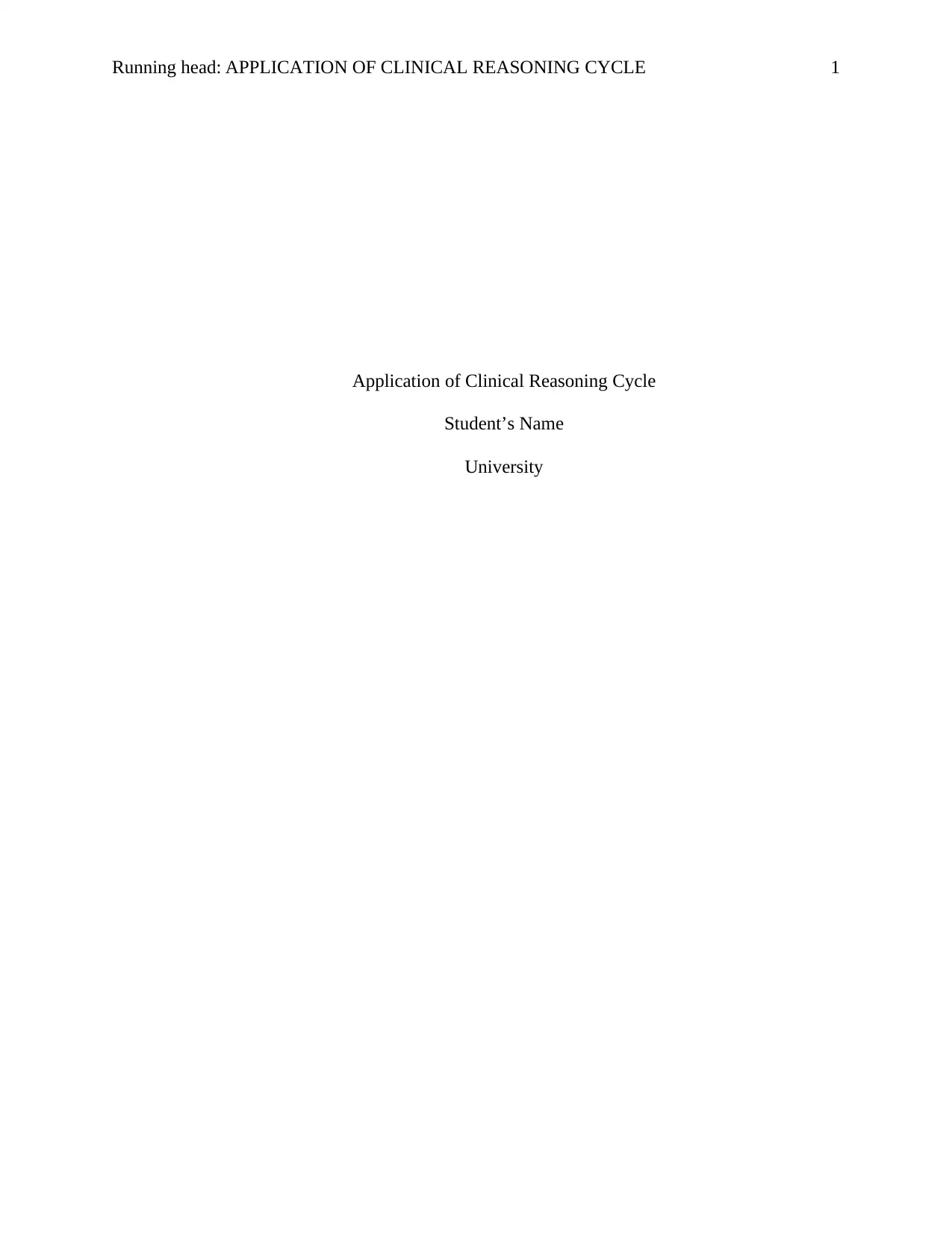
Running head: APPLICATION OF CLINICAL REASONING CYCLE 1
Application of Clinical Reasoning Cycle
Student’s Name
University
Application of Clinical Reasoning Cycle
Student’s Name
University
Paraphrase This Document
Need a fresh take? Get an instant paraphrase of this document with our AI Paraphraser
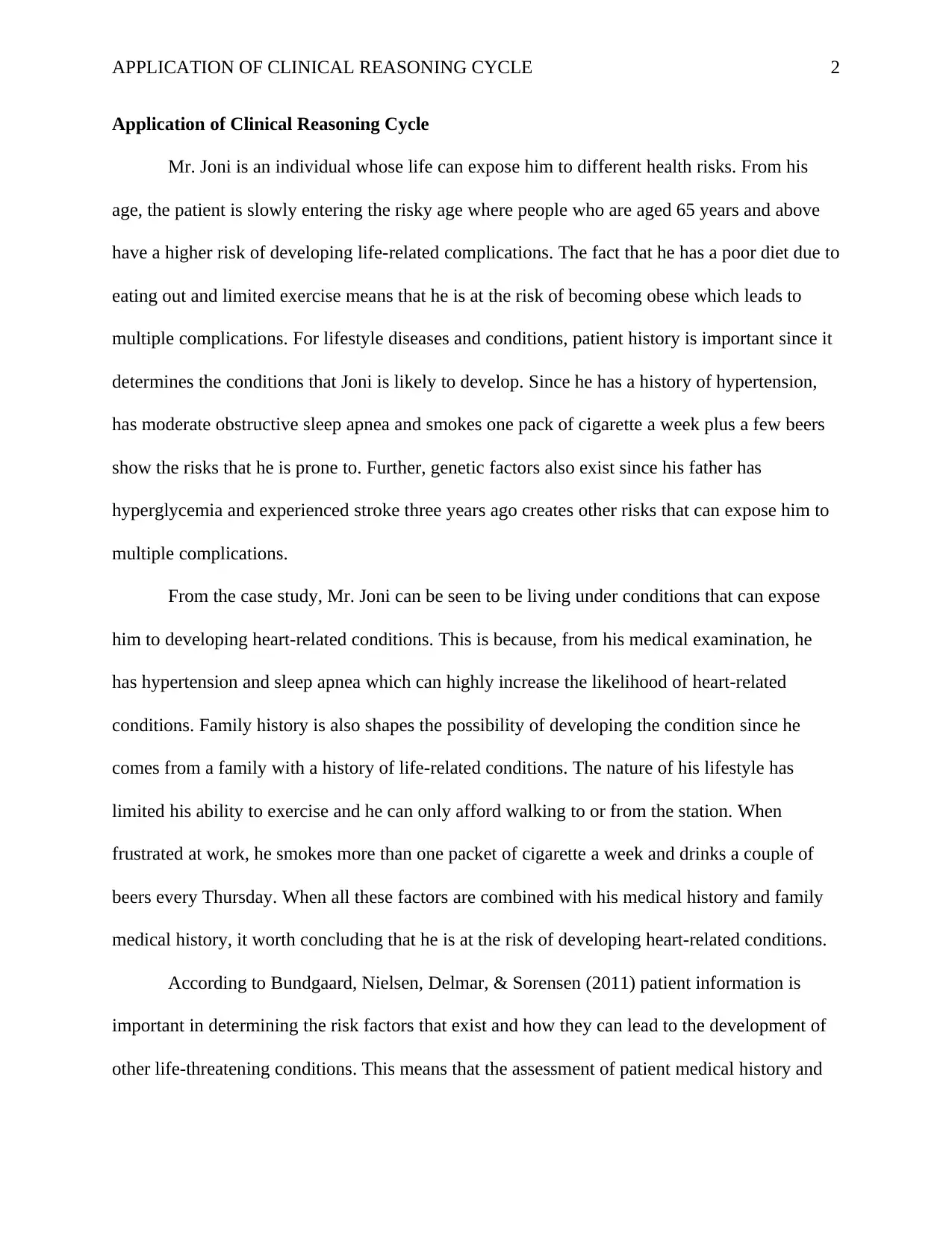
APPLICATION OF CLINICAL REASONING CYCLE 2
Application of Clinical Reasoning Cycle
Mr. Joni is an individual whose life can expose him to different health risks. From his
age, the patient is slowly entering the risky age where people who are aged 65 years and above
have a higher risk of developing life-related complications. The fact that he has a poor diet due to
eating out and limited exercise means that he is at the risk of becoming obese which leads to
multiple complications. For lifestyle diseases and conditions, patient history is important since it
determines the conditions that Joni is likely to develop. Since he has a history of hypertension,
has moderate obstructive sleep apnea and smokes one pack of cigarette a week plus a few beers
show the risks that he is prone to. Further, genetic factors also exist since his father has
hyperglycemia and experienced stroke three years ago creates other risks that can expose him to
multiple complications.
From the case study, Mr. Joni can be seen to be living under conditions that can expose
him to developing heart-related conditions. This is because, from his medical examination, he
has hypertension and sleep apnea which can highly increase the likelihood of heart-related
conditions. Family history is also shapes the possibility of developing the condition since he
comes from a family with a history of life-related conditions. The nature of his lifestyle has
limited his ability to exercise and he can only afford walking to or from the station. When
frustrated at work, he smokes more than one packet of cigarette a week and drinks a couple of
beers every Thursday. When all these factors are combined with his medical history and family
medical history, it worth concluding that he is at the risk of developing heart-related conditions.
According to Bundgaard, Nielsen, Delmar, & Sorensen (2011) patient information is
important in determining the risk factors that exist and how they can lead to the development of
other life-threatening conditions. This means that the assessment of patient medical history and
Application of Clinical Reasoning Cycle
Mr. Joni is an individual whose life can expose him to different health risks. From his
age, the patient is slowly entering the risky age where people who are aged 65 years and above
have a higher risk of developing life-related complications. The fact that he has a poor diet due to
eating out and limited exercise means that he is at the risk of becoming obese which leads to
multiple complications. For lifestyle diseases and conditions, patient history is important since it
determines the conditions that Joni is likely to develop. Since he has a history of hypertension,
has moderate obstructive sleep apnea and smokes one pack of cigarette a week plus a few beers
show the risks that he is prone to. Further, genetic factors also exist since his father has
hyperglycemia and experienced stroke three years ago creates other risks that can expose him to
multiple complications.
From the case study, Mr. Joni can be seen to be living under conditions that can expose
him to developing heart-related conditions. This is because, from his medical examination, he
has hypertension and sleep apnea which can highly increase the likelihood of heart-related
conditions. Family history is also shapes the possibility of developing the condition since he
comes from a family with a history of life-related conditions. The nature of his lifestyle has
limited his ability to exercise and he can only afford walking to or from the station. When
frustrated at work, he smokes more than one packet of cigarette a week and drinks a couple of
beers every Thursday. When all these factors are combined with his medical history and family
medical history, it worth concluding that he is at the risk of developing heart-related conditions.
According to Bundgaard, Nielsen, Delmar, & Sorensen (2011) patient information is
important in determining the risk factors that exist and how they can lead to the development of
other life-threatening conditions. This means that the assessment of patient medical history and
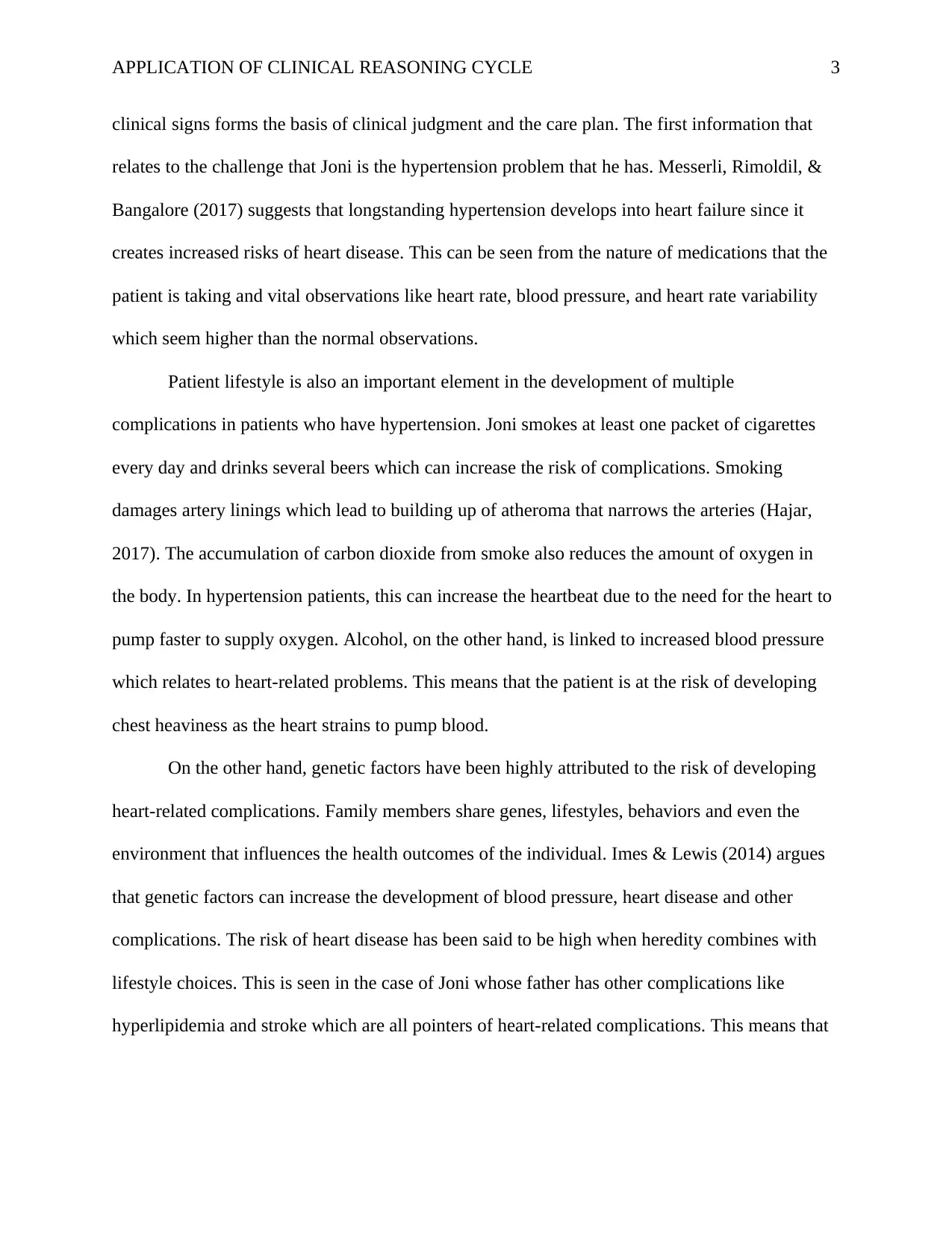
APPLICATION OF CLINICAL REASONING CYCLE 3
clinical signs forms the basis of clinical judgment and the care plan. The first information that
relates to the challenge that Joni is the hypertension problem that he has. Messerli, Rimoldil, &
Bangalore (2017) suggests that longstanding hypertension develops into heart failure since it
creates increased risks of heart disease. This can be seen from the nature of medications that the
patient is taking and vital observations like heart rate, blood pressure, and heart rate variability
which seem higher than the normal observations.
Patient lifestyle is also an important element in the development of multiple
complications in patients who have hypertension. Joni smokes at least one packet of cigarettes
every day and drinks several beers which can increase the risk of complications. Smoking
damages artery linings which lead to building up of atheroma that narrows the arteries (Hajar,
2017). The accumulation of carbon dioxide from smoke also reduces the amount of oxygen in
the body. In hypertension patients, this can increase the heartbeat due to the need for the heart to
pump faster to supply oxygen. Alcohol, on the other hand, is linked to increased blood pressure
which relates to heart-related problems. This means that the patient is at the risk of developing
chest heaviness as the heart strains to pump blood.
On the other hand, genetic factors have been highly attributed to the risk of developing
heart-related complications. Family members share genes, lifestyles, behaviors and even the
environment that influences the health outcomes of the individual. Imes & Lewis (2014) argues
that genetic factors can increase the development of blood pressure, heart disease and other
complications. The risk of heart disease has been said to be high when heredity combines with
lifestyle choices. This is seen in the case of Joni whose father has other complications like
hyperlipidemia and stroke which are all pointers of heart-related complications. This means that
clinical signs forms the basis of clinical judgment and the care plan. The first information that
relates to the challenge that Joni is the hypertension problem that he has. Messerli, Rimoldil, &
Bangalore (2017) suggests that longstanding hypertension develops into heart failure since it
creates increased risks of heart disease. This can be seen from the nature of medications that the
patient is taking and vital observations like heart rate, blood pressure, and heart rate variability
which seem higher than the normal observations.
Patient lifestyle is also an important element in the development of multiple
complications in patients who have hypertension. Joni smokes at least one packet of cigarettes
every day and drinks several beers which can increase the risk of complications. Smoking
damages artery linings which lead to building up of atheroma that narrows the arteries (Hajar,
2017). The accumulation of carbon dioxide from smoke also reduces the amount of oxygen in
the body. In hypertension patients, this can increase the heartbeat due to the need for the heart to
pump faster to supply oxygen. Alcohol, on the other hand, is linked to increased blood pressure
which relates to heart-related problems. This means that the patient is at the risk of developing
chest heaviness as the heart strains to pump blood.
On the other hand, genetic factors have been highly attributed to the risk of developing
heart-related complications. Family members share genes, lifestyles, behaviors and even the
environment that influences the health outcomes of the individual. Imes & Lewis (2014) argues
that genetic factors can increase the development of blood pressure, heart disease and other
complications. The risk of heart disease has been said to be high when heredity combines with
lifestyle choices. This is seen in the case of Joni whose father has other complications like
hyperlipidemia and stroke which are all pointers of heart-related complications. This means that
⊘ This is a preview!⊘
Do you want full access?
Subscribe today to unlock all pages.

Trusted by 1+ million students worldwide
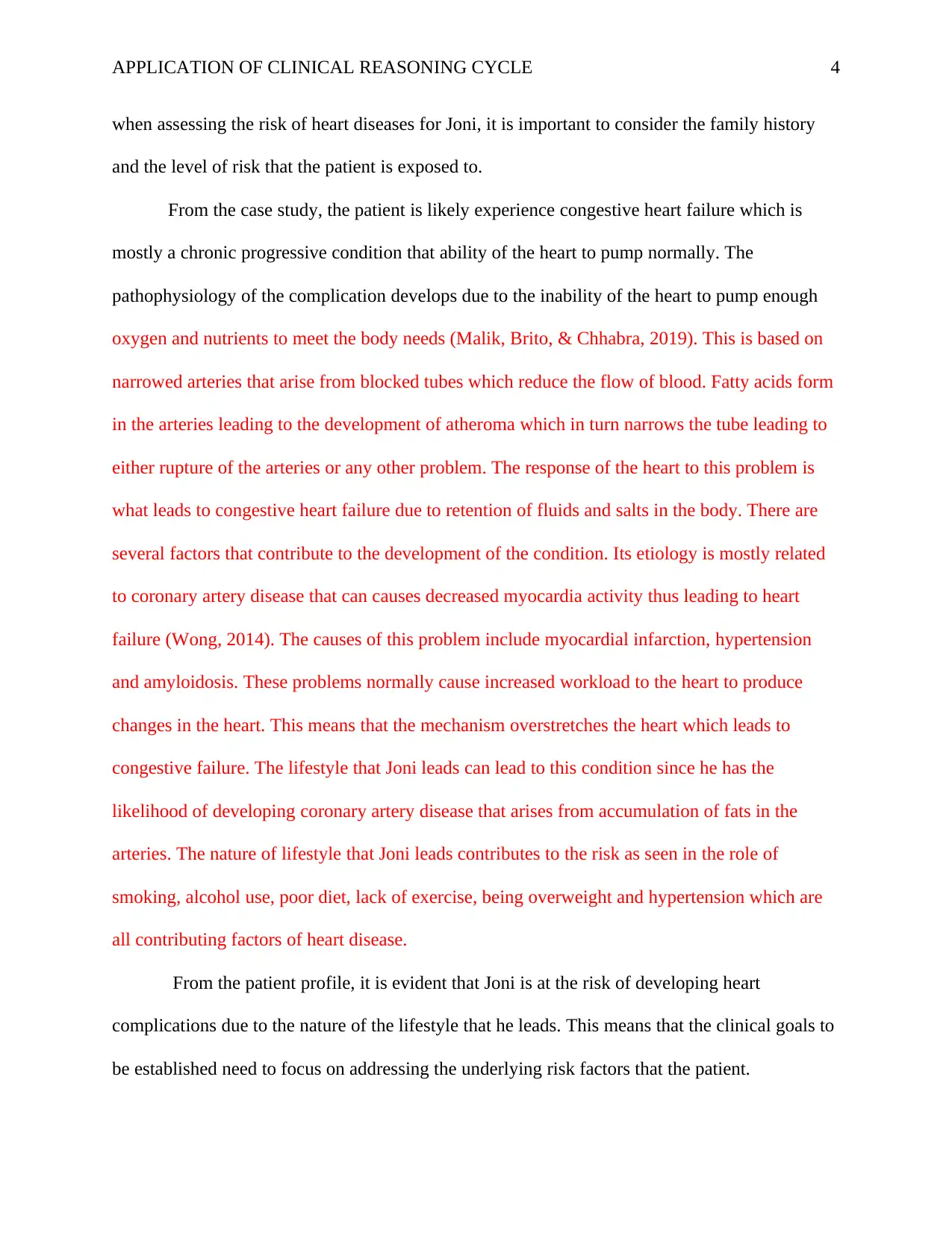
APPLICATION OF CLINICAL REASONING CYCLE 4
when assessing the risk of heart diseases for Joni, it is important to consider the family history
and the level of risk that the patient is exposed to.
From the case study, the patient is likely experience congestive heart failure which is
mostly a chronic progressive condition that ability of the heart to pump normally. The
pathophysiology of the complication develops due to the inability of the heart to pump enough
oxygen and nutrients to meet the body needs (Malik, Brito, & Chhabra, 2019). This is based on
narrowed arteries that arise from blocked tubes which reduce the flow of blood. Fatty acids form
in the arteries leading to the development of atheroma which in turn narrows the tube leading to
either rupture of the arteries or any other problem. The response of the heart to this problem is
what leads to congestive heart failure due to retention of fluids and salts in the body. There are
several factors that contribute to the development of the condition. Its etiology is mostly related
to coronary artery disease that can causes decreased myocardia activity thus leading to heart
failure (Wong, 2014). The causes of this problem include myocardial infarction, hypertension
and amyloidosis. These problems normally cause increased workload to the heart to produce
changes in the heart. This means that the mechanism overstretches the heart which leads to
congestive failure. The lifestyle that Joni leads can lead to this condition since he has the
likelihood of developing coronary artery disease that arises from accumulation of fats in the
arteries. The nature of lifestyle that Joni leads contributes to the risk as seen in the role of
smoking, alcohol use, poor diet, lack of exercise, being overweight and hypertension which are
all contributing factors of heart disease.
From the patient profile, it is evident that Joni is at the risk of developing heart
complications due to the nature of the lifestyle that he leads. This means that the clinical goals to
be established need to focus on addressing the underlying risk factors that the patient.
when assessing the risk of heart diseases for Joni, it is important to consider the family history
and the level of risk that the patient is exposed to.
From the case study, the patient is likely experience congestive heart failure which is
mostly a chronic progressive condition that ability of the heart to pump normally. The
pathophysiology of the complication develops due to the inability of the heart to pump enough
oxygen and nutrients to meet the body needs (Malik, Brito, & Chhabra, 2019). This is based on
narrowed arteries that arise from blocked tubes which reduce the flow of blood. Fatty acids form
in the arteries leading to the development of atheroma which in turn narrows the tube leading to
either rupture of the arteries or any other problem. The response of the heart to this problem is
what leads to congestive heart failure due to retention of fluids and salts in the body. There are
several factors that contribute to the development of the condition. Its etiology is mostly related
to coronary artery disease that can causes decreased myocardia activity thus leading to heart
failure (Wong, 2014). The causes of this problem include myocardial infarction, hypertension
and amyloidosis. These problems normally cause increased workload to the heart to produce
changes in the heart. This means that the mechanism overstretches the heart which leads to
congestive failure. The lifestyle that Joni leads can lead to this condition since he has the
likelihood of developing coronary artery disease that arises from accumulation of fats in the
arteries. The nature of lifestyle that Joni leads contributes to the risk as seen in the role of
smoking, alcohol use, poor diet, lack of exercise, being overweight and hypertension which are
all contributing factors of heart disease.
From the patient profile, it is evident that Joni is at the risk of developing heart
complications due to the nature of the lifestyle that he leads. This means that the clinical goals to
be established need to focus on addressing the underlying risk factors that the patient.
Paraphrase This Document
Need a fresh take? Get an instant paraphrase of this document with our AI Paraphraser
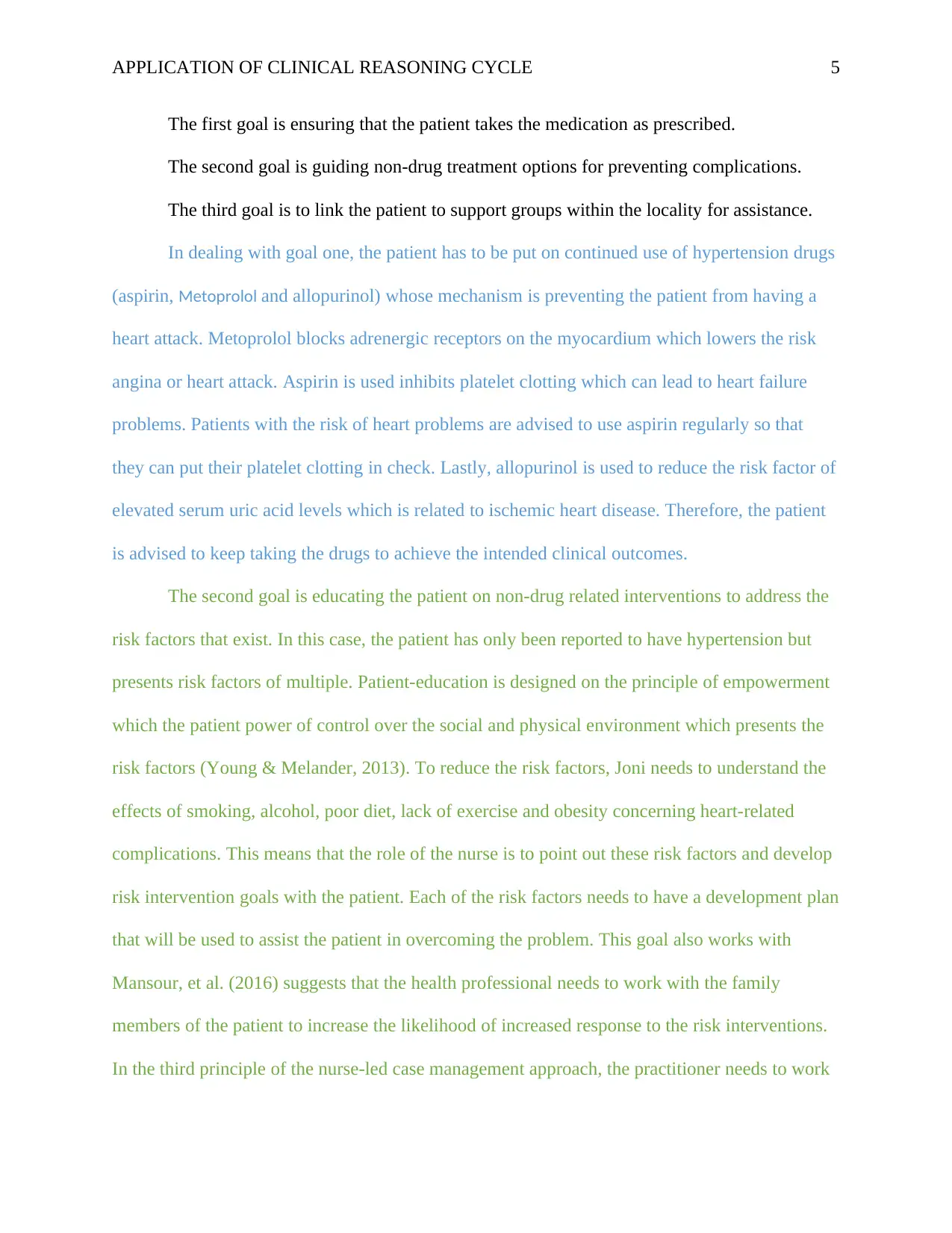
APPLICATION OF CLINICAL REASONING CYCLE 5
The first goal is ensuring that the patient takes the medication as prescribed.
The second goal is guiding non-drug treatment options for preventing complications.
The third goal is to link the patient to support groups within the locality for assistance.
In dealing with goal one, the patient has to be put on continued use of hypertension drugs
(aspirin, Metoprolol and allopurinol) whose mechanism is preventing the patient from having a
heart attack. Metoprolol blocks adrenergic receptors on the myocardium which lowers the risk
angina or heart attack. Aspirin is used inhibits platelet clotting which can lead to heart failure
problems. Patients with the risk of heart problems are advised to use aspirin regularly so that
they can put their platelet clotting in check. Lastly, allopurinol is used to reduce the risk factor of
elevated serum uric acid levels which is related to ischemic heart disease. Therefore, the patient
is advised to keep taking the drugs to achieve the intended clinical outcomes.
The second goal is educating the patient on non-drug related interventions to address the
risk factors that exist. In this case, the patient has only been reported to have hypertension but
presents risk factors of multiple. Patient-education is designed on the principle of empowerment
which the patient power of control over the social and physical environment which presents the
risk factors (Young & Melander, 2013). To reduce the risk factors, Joni needs to understand the
effects of smoking, alcohol, poor diet, lack of exercise and obesity concerning heart-related
complications. This means that the role of the nurse is to point out these risk factors and develop
risk intervention goals with the patient. Each of the risk factors needs to have a development plan
that will be used to assist the patient in overcoming the problem. This goal also works with
Mansour, et al. (2016) suggests that the health professional needs to work with the family
members of the patient to increase the likelihood of increased response to the risk interventions.
In the third principle of the nurse-led case management approach, the practitioner needs to work
The first goal is ensuring that the patient takes the medication as prescribed.
The second goal is guiding non-drug treatment options for preventing complications.
The third goal is to link the patient to support groups within the locality for assistance.
In dealing with goal one, the patient has to be put on continued use of hypertension drugs
(aspirin, Metoprolol and allopurinol) whose mechanism is preventing the patient from having a
heart attack. Metoprolol blocks adrenergic receptors on the myocardium which lowers the risk
angina or heart attack. Aspirin is used inhibits platelet clotting which can lead to heart failure
problems. Patients with the risk of heart problems are advised to use aspirin regularly so that
they can put their platelet clotting in check. Lastly, allopurinol is used to reduce the risk factor of
elevated serum uric acid levels which is related to ischemic heart disease. Therefore, the patient
is advised to keep taking the drugs to achieve the intended clinical outcomes.
The second goal is educating the patient on non-drug related interventions to address the
risk factors that exist. In this case, the patient has only been reported to have hypertension but
presents risk factors of multiple. Patient-education is designed on the principle of empowerment
which the patient power of control over the social and physical environment which presents the
risk factors (Young & Melander, 2013). To reduce the risk factors, Joni needs to understand the
effects of smoking, alcohol, poor diet, lack of exercise and obesity concerning heart-related
complications. This means that the role of the nurse is to point out these risk factors and develop
risk intervention goals with the patient. Each of the risk factors needs to have a development plan
that will be used to assist the patient in overcoming the problem. This goal also works with
Mansour, et al. (2016) suggests that the health professional needs to work with the family
members of the patient to increase the likelihood of increased response to the risk interventions.
In the third principle of the nurse-led case management approach, the practitioner needs to work
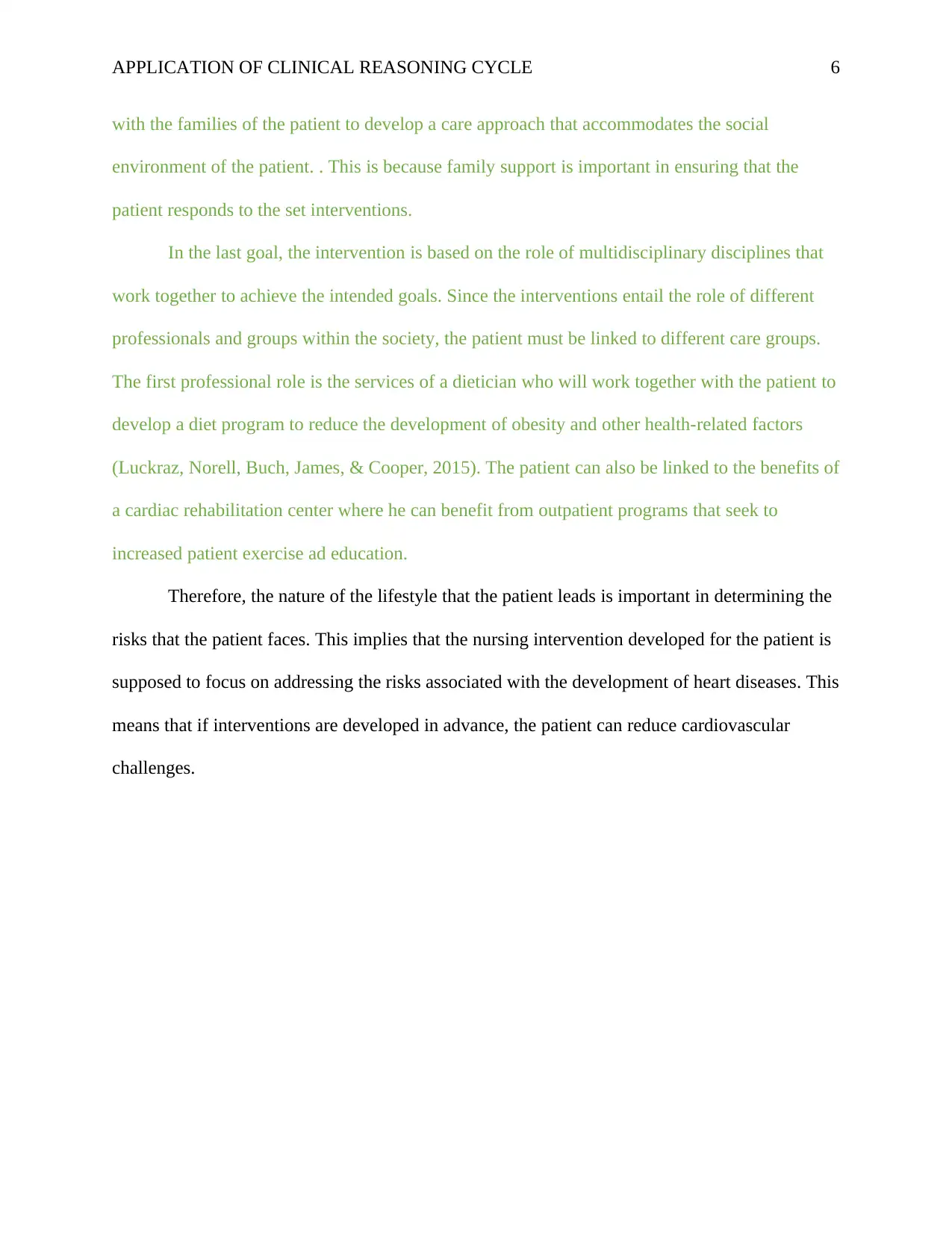
APPLICATION OF CLINICAL REASONING CYCLE 6
with the families of the patient to develop a care approach that accommodates the social
environment of the patient. . This is because family support is important in ensuring that the
patient responds to the set interventions.
In the last goal, the intervention is based on the role of multidisciplinary disciplines that
work together to achieve the intended goals. Since the interventions entail the role of different
professionals and groups within the society, the patient must be linked to different care groups.
The first professional role is the services of a dietician who will work together with the patient to
develop a diet program to reduce the development of obesity and other health-related factors
(Luckraz, Norell, Buch, James, & Cooper, 2015). The patient can also be linked to the benefits of
a cardiac rehabilitation center where he can benefit from outpatient programs that seek to
increased patient exercise ad education.
Therefore, the nature of the lifestyle that the patient leads is important in determining the
risks that the patient faces. This implies that the nursing intervention developed for the patient is
supposed to focus on addressing the risks associated with the development of heart diseases. This
means that if interventions are developed in advance, the patient can reduce cardiovascular
challenges.
with the families of the patient to develop a care approach that accommodates the social
environment of the patient. . This is because family support is important in ensuring that the
patient responds to the set interventions.
In the last goal, the intervention is based on the role of multidisciplinary disciplines that
work together to achieve the intended goals. Since the interventions entail the role of different
professionals and groups within the society, the patient must be linked to different care groups.
The first professional role is the services of a dietician who will work together with the patient to
develop a diet program to reduce the development of obesity and other health-related factors
(Luckraz, Norell, Buch, James, & Cooper, 2015). The patient can also be linked to the benefits of
a cardiac rehabilitation center where he can benefit from outpatient programs that seek to
increased patient exercise ad education.
Therefore, the nature of the lifestyle that the patient leads is important in determining the
risks that the patient faces. This implies that the nursing intervention developed for the patient is
supposed to focus on addressing the risks associated with the development of heart diseases. This
means that if interventions are developed in advance, the patient can reduce cardiovascular
challenges.
⊘ This is a preview!⊘
Do you want full access?
Subscribe today to unlock all pages.

Trusted by 1+ million students worldwide
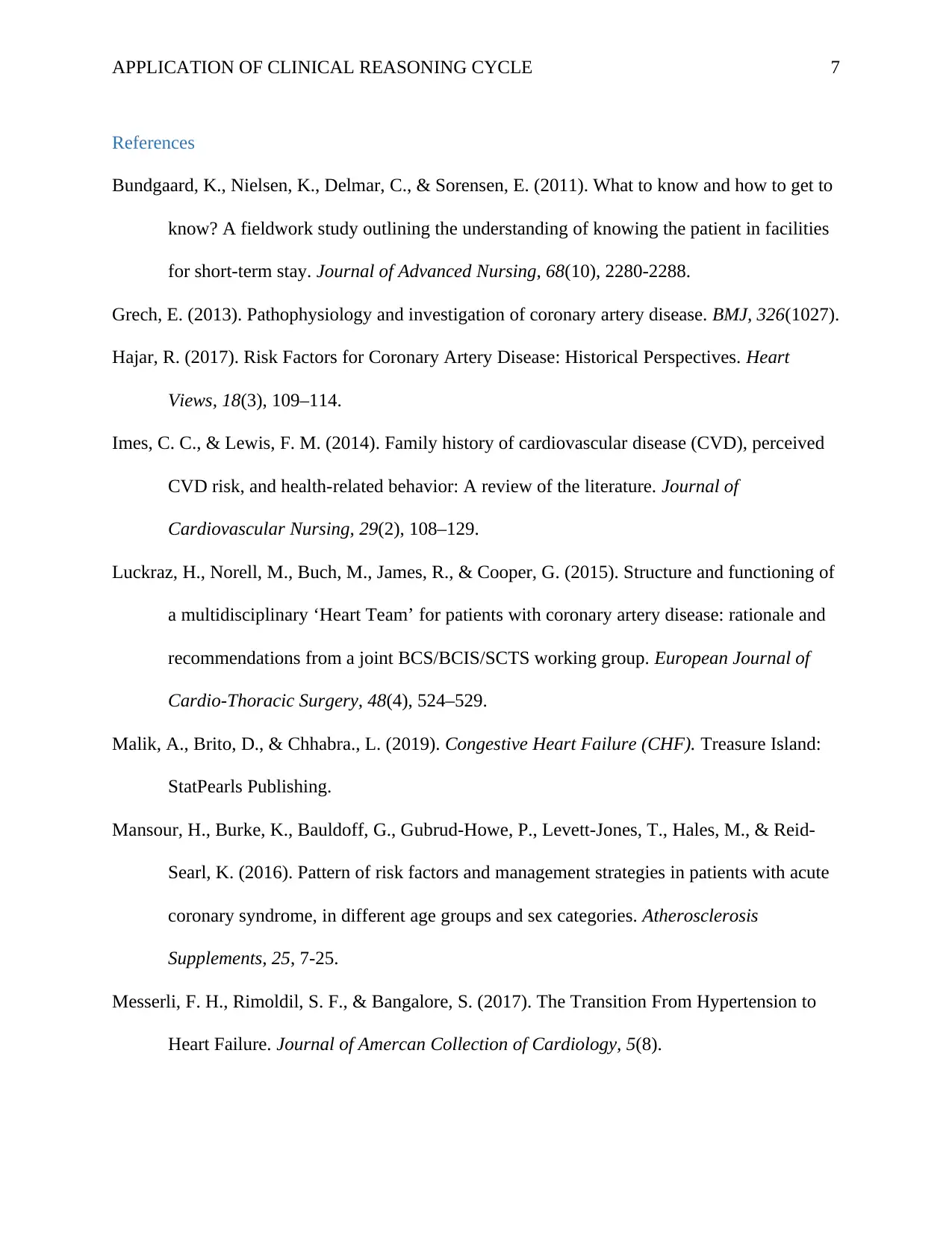
APPLICATION OF CLINICAL REASONING CYCLE 7
References
Bundgaard, K., Nielsen, K., Delmar, C., & Sorensen, E. (2011). What to know and how to get to
know? A fieldwork study outlining the understanding of knowing the patient in facilities
for short-term stay. Journal of Advanced Nursing, 68(10), 2280-2288.
Grech, E. (2013). Pathophysiology and investigation of coronary artery disease. BMJ, 326(1027).
Hajar, R. (2017). Risk Factors for Coronary Artery Disease: Historical Perspectives. Heart
Views, 18(3), 109–114.
Imes, C. C., & Lewis, F. M. (2014). Family history of cardiovascular disease (CVD), perceived
CVD risk, and health-related behavior: A review of the literature. Journal of
Cardiovascular Nursing, 29(2), 108–129.
Luckraz, H., Norell, M., Buch, M., James, R., & Cooper, G. (2015). Structure and functioning of
a multidisciplinary ‘Heart Team’ for patients with coronary artery disease: rationale and
recommendations from a joint BCS/BCIS/SCTS working group. European Journal of
Cardio-Thoracic Surgery, 48(4), 524–529.
Malik, A., Brito, D., & Chhabra., L. (2019). Congestive Heart Failure (CHF). Treasure Island:
StatPearls Publishing.
Mansour, H., Burke, K., Bauldoff, G., Gubrud-Howe, P., Levett-Jones, T., Hales, M., & Reid-
Searl, K. (2016). Pattern of risk factors and management strategies in patients with acute
coronary syndrome, in different age groups and sex categories. Atherosclerosis
Supplements, 25, 7-25.
Messerli, F. H., Rimoldil, S. F., & Bangalore, S. (2017). The Transition From Hypertension to
Heart Failure. Journal of Amercan Collection of Cardiology, 5(8).
References
Bundgaard, K., Nielsen, K., Delmar, C., & Sorensen, E. (2011). What to know and how to get to
know? A fieldwork study outlining the understanding of knowing the patient in facilities
for short-term stay. Journal of Advanced Nursing, 68(10), 2280-2288.
Grech, E. (2013). Pathophysiology and investigation of coronary artery disease. BMJ, 326(1027).
Hajar, R. (2017). Risk Factors for Coronary Artery Disease: Historical Perspectives. Heart
Views, 18(3), 109–114.
Imes, C. C., & Lewis, F. M. (2014). Family history of cardiovascular disease (CVD), perceived
CVD risk, and health-related behavior: A review of the literature. Journal of
Cardiovascular Nursing, 29(2), 108–129.
Luckraz, H., Norell, M., Buch, M., James, R., & Cooper, G. (2015). Structure and functioning of
a multidisciplinary ‘Heart Team’ for patients with coronary artery disease: rationale and
recommendations from a joint BCS/BCIS/SCTS working group. European Journal of
Cardio-Thoracic Surgery, 48(4), 524–529.
Malik, A., Brito, D., & Chhabra., L. (2019). Congestive Heart Failure (CHF). Treasure Island:
StatPearls Publishing.
Mansour, H., Burke, K., Bauldoff, G., Gubrud-Howe, P., Levett-Jones, T., Hales, M., & Reid-
Searl, K. (2016). Pattern of risk factors and management strategies in patients with acute
coronary syndrome, in different age groups and sex categories. Atherosclerosis
Supplements, 25, 7-25.
Messerli, F. H., Rimoldil, S. F., & Bangalore, S. (2017). The Transition From Hypertension to
Heart Failure. Journal of Amercan Collection of Cardiology, 5(8).
Paraphrase This Document
Need a fresh take? Get an instant paraphrase of this document with our AI Paraphraser
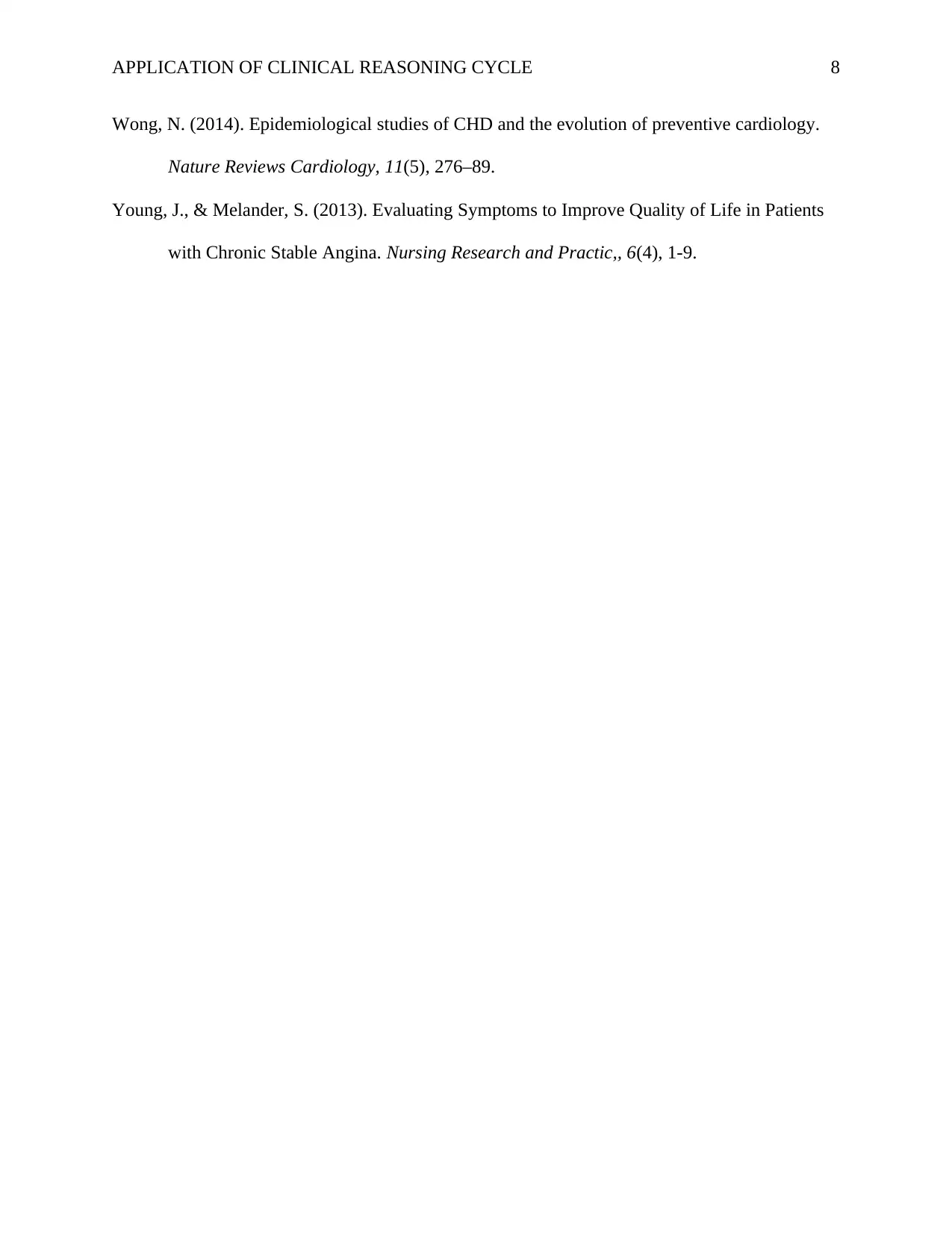
APPLICATION OF CLINICAL REASONING CYCLE 8
Wong, N. (2014). Epidemiological studies of CHD and the evolution of preventive cardiology.
Nature Reviews Cardiology, 11(5), 276–89.
Young, J., & Melander, S. (2013). Evaluating Symptoms to Improve Quality of Life in Patients
with Chronic Stable Angina. Nursing Research and Practic,, 6(4), 1-9.
Wong, N. (2014). Epidemiological studies of CHD and the evolution of preventive cardiology.
Nature Reviews Cardiology, 11(5), 276–89.
Young, J., & Melander, S. (2013). Evaluating Symptoms to Improve Quality of Life in Patients
with Chronic Stable Angina. Nursing Research and Practic,, 6(4), 1-9.
1 out of 8
Related Documents
Your All-in-One AI-Powered Toolkit for Academic Success.
+13062052269
info@desklib.com
Available 24*7 on WhatsApp / Email
![[object Object]](/_next/static/media/star-bottom.7253800d.svg)
Unlock your academic potential
Copyright © 2020–2025 A2Z Services. All Rights Reserved. Developed and managed by ZUCOL.




